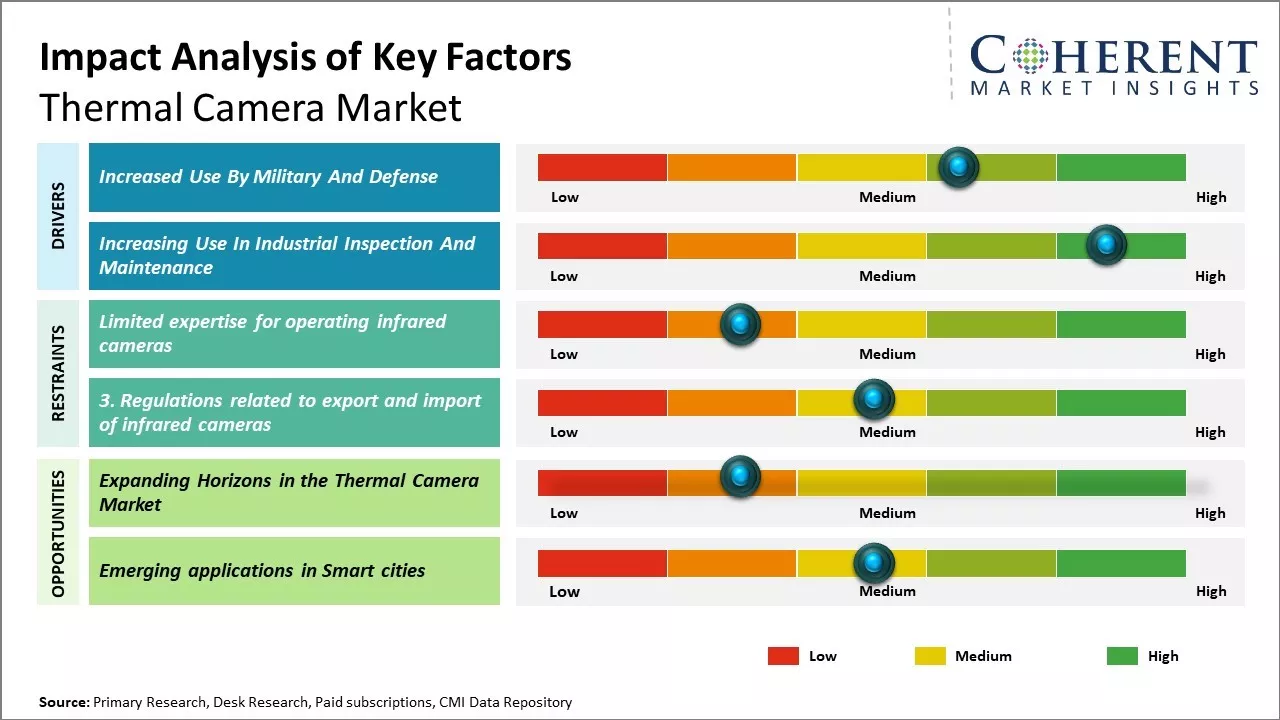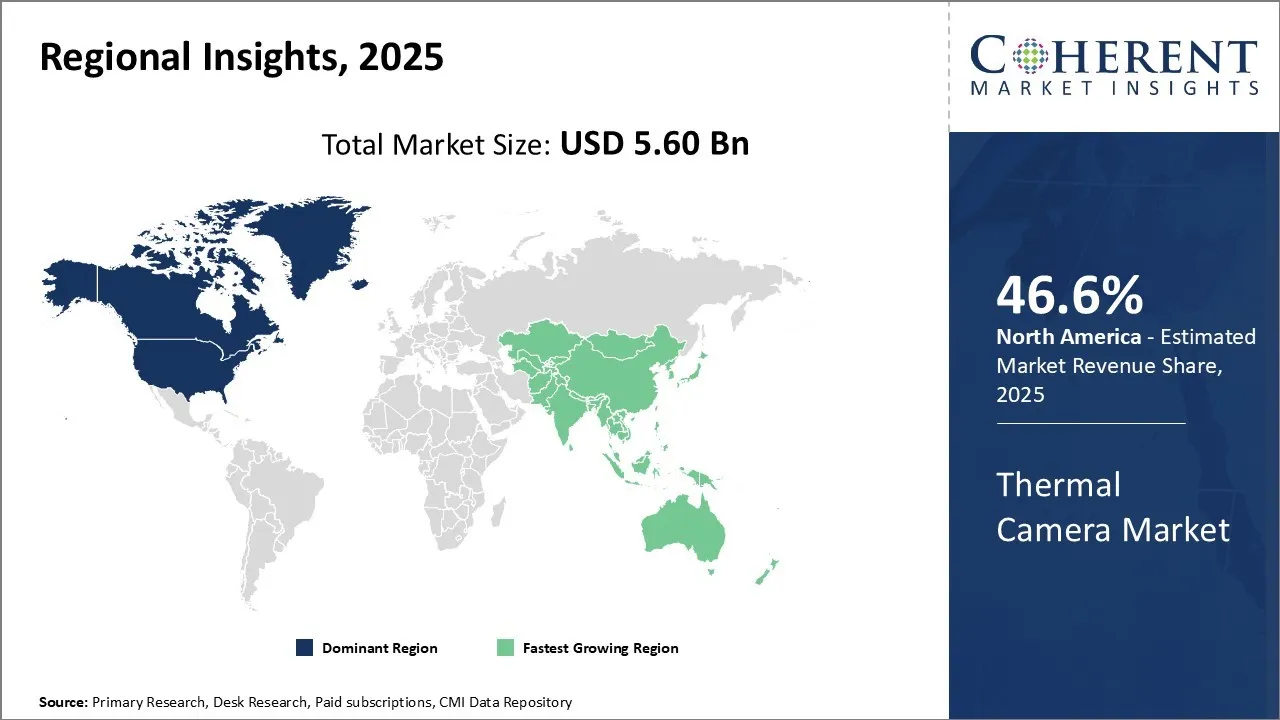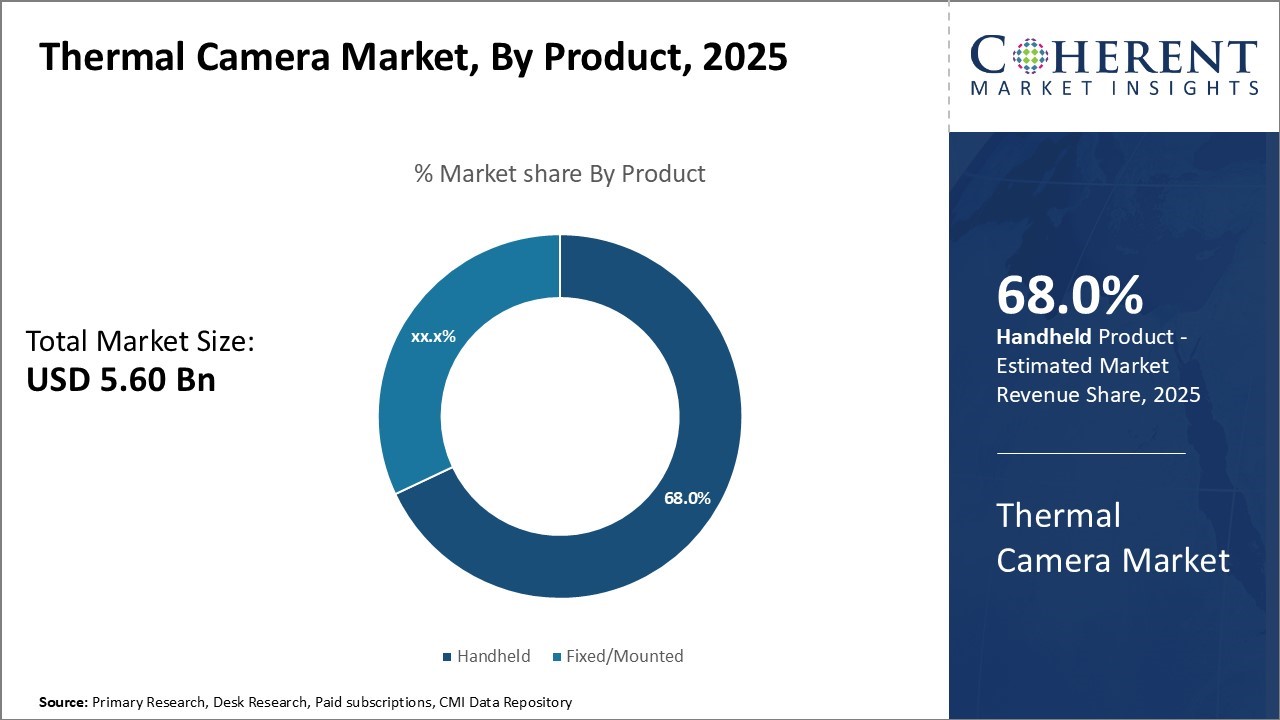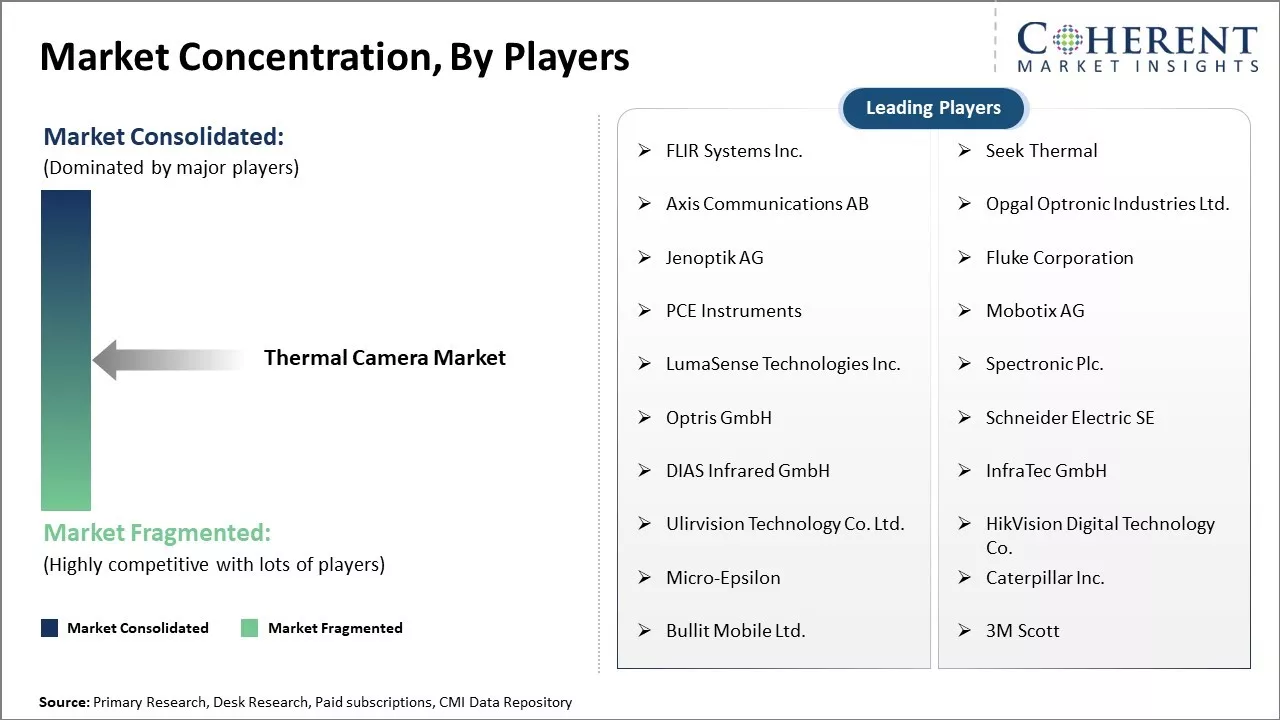Thermal Camera Market Size and Trends & Growth – 2025 to 2032
The thermal camera market is estimated to be valued at USD 5.60 Bn in 2025 and is expected to reach USD 10.70 Bn by 2032, growing at a compound annual growth rate (CAGR) of 9.7% from 2025 to 2032.

To learn more about this report, Download Free Sample
Key Takeaways
- On the basis of Product Type, Handheld Thermal Cameras, contributing approximately 68% of the global market share. Their portability and increasing deployment in field diagnostics, preventive maintenance, and emergency response drive their strong adoption across industries.
- On the basis of Technology, Cooled Thermal Cameras are widely preferred due to their affordability contributing around 63.5% of the global share market.
- On the basis of Application, defense & military operations is contributing 48.7% of the global market share. Rising emphasis on predictive maintenance and non-contact temperature screening has further accelerated demand in these sectors.
- On the basis of Region, North America leads the global thermal camera market, accounting for approximately 46.6%of the total market share. The region’s dominance is driven by strong defense spending, high adoption in industrial safety, and increasing integration of thermal imaging in smart buildings and infrastructure.
Market Overview
Thermal cameras, also known as thermal imaging or infrared cameras, detect infrared radiation, and produce images based on differences in surface temperature. Thermal cameras are used across various industries like security and surveillance, firefighting, predictive maintenance in industries, thermography in building inspections, research and design, and automotive applications. The global thermal camera market is growing due to increasing applications of thermal imaging cameras in the commercial and industrial sectors. The thermal camera market is expected to witness significant growth over the forecast period. Increased application across various industries such as automotive, military and defense, electronics and communication, and others is driving the demand for thermal cameras. Moreover, technological advancements leading to enhanced features and reduced production costs have made thermal cameras more accessible. The miniaturization of cameras with improved resolution and accuracy is further facilitating their adoption. Growing investments by leading players to develop advanced thermal imaging solutions will continue propelling the thermal camera market forward in the coming years.
Current Events and Its Impact
|
Current Events |
Description and its impact |
|
Escalating Geopolitical Tensions and Conflicts
|
|
|
Climate Change and Rising Environmental Concerns |
|
|
Emerging Commercial and Industrial Application Trends |
|
Uncover macros and micros vetted on 75+ parameters: Get instant access to report
Role of AI in Thermal Camera Market
Artificial Intelligence (AI) is significantly enhancing the capabilities and applications of thermal cameras, transforming them from basic imaging devices into highly intelligent tools capable of analyzing, predicting, and making real-time decisions. AI’s integration into thermal camera systems is driving innovation, improving accuracy, and expanding the range of potential uses across industries. In February 2024, Hanwha Vision, a global provider of vision solutions, introduced a new range of AI-powered high-performance radiometric thermal cameras. These compact cameras are designed to deliver precise temperature measurements, ranging from -40°C to 550°C, while also offering security and surveillance capabilities. They are ideal for industrial sectors such as manufacturing, utilities, energy, as well as for airports, shipping, and mining industries.
Pricing Analysis for Thermal Cameras
Thermal camera pricing varies widely based on factors like resolution, features, application, and portability. Here's a concise breakdown:
- Low-Resolution Cameras (80 x 60 to 160 x 120 pixels): Entry-level models for general use, priced from $200 to $1,000. Example: Fluke VT04 ($800).
- Mid-Resolution Cameras (320 x 240 to 640 x 480 pixels): Used in industries like HVAC and energy audits, costing $1,000 to $5,000. Example: FLIR E8-XT ($3,000).
- High-Resolution Cameras (1280 x 720 to 1920 x 1080 pixels): For precision tasks in medical or aerospace, priced from $5,000 to $50,000+. Example: FLIR T1020 ($20,000).
Key Factors Affecting Pricing
- Features & Functionality: AI-enhanced and radiometric cameras are pricier. AI-powered models range from $2,000 to $10,000 (e.g., Hanwha Vision AI cameras).
- Application-Specific: Industrial models cost $1,000 to $10,000, while military or medical-grade models can exceed $20,000.
- Portability: Compact, portable models are typically priced from $200 to $3,000, like the Fluke VT04.
Thermal Camera Market Insights, By Product: Portability and affordability drive handheld growth
In terms of product, handheld contributes the highest share of 68.0% in 2025 of the market owing to its portability and affordability. As the name suggests, handheld thermal cameras are highly portable devices that can easily be carried around for on-site inspections and surveys. Their compactness allows users to easily maneuver them in tight spaces and areas with restricted access. This makes them ideal for applications like building inspections, where inspectors need to visually examine the outer and inner structures from up-close. In October 2024, Fluke introduced a compact, portable thermal camera that. It provides detailed images on par with professional cameras, along with complete temperature range analysis.
In addition, handheld cameras tend to be more affordable than fixed models, putting thermal imaging technology within reach of smaller businesses and individual users. Their lower cost of ownership expands the potential customer base for Original Equipment manufacturer (OEMs). Some key factors propelling the handheld segment are the growing demand from building inspectors and facilities managers, and an increasing focus on preventive maintenance across industries. OEMs have also enhanced handheld models with improved resolutions, larger screens, longer battery lives, and additional features to appeal to professional users. This is further accelerating the thermal camera market demand.
Thermal Camera Market Insights, By Technology: Technological superiority drives cooled cameras
In terms of technology, cooled contributes the highest share of 63.5% in 2025 of the market owing to its technological superiority over uncooled cameras. Cooled cameras use cryogenically cooled focal plane arrays that offer unmatched temperature sensitivity and image quality. Their detection system is kept at very low temperatures, typically around -200°C, using thermoelectric coolers or Stirling cycle coolers. This minimizes thermal noise for much higher sensitivity down to 20mK. As a result, cooled cameras are capable of detecting smaller temperature differences and capturing finer details. They find widespread adoption where the most accurate real-time temperature data is imperative, such as in aircraft engine testing, predictive maintenance of industrial assets, and R&D. Advanced vanadium oxide microbolometers used in high-end uncooled cameras cannot match the sensitivity and resolution of Moreover, cooled cameras offer temperature measurement precision around ±1°C, while uncooled cameras are only ±5°C. This superiority comes at the cost of higher price tags, maintenance needs, and power requirements. However, ongoing technology advances are making cooled cameras more affordable and compact.
In thermal camera technology, Butlr, an MIT Media Lab spinout, has pioneered a privacy-centric approach to smart building solutions. Their system utilizes low-resolution thermal sensors combined with AI-driven analytics to monitor human presence and movement without capturing personally identifiable information. This innovation enables applications such as fall detection in elderly care, energy optimization, and workspace utilization, all while maintaining occupant privacy, further propelling the thermal camera industry demand.
Thermal Camera Market Insights, By Application: Defense demands drive growth in defense & military applications
In terms of application, defense & military contributes the highest share of 48.7% in 2025 of the market owing to the critical needs of this sector. Thermal cameras see extensive use in defense and military applications for surveillance, border monitoring, and personnel/vehicle detection. They enable round-the-clock situational awareness under any lighting condition. With their ability to detect minute temperature variations, these cameras help identify concealed objects, camouflaged targets, and ambush sites invisible to the naked eye. They augment night vision capability of armed forces to safeguard national borders.
Additionally, thermal sensors are used in fire control systems, driver vision enhancement, and biometric screening. Their non-intrusive imaging allows covert missions without alerting hostiles. Leading defense agencies globally are investing heavily in upgrading their thermal imaging equipment for enhanced precision, connectivity and analytics. Strict military specifications also support technology progression. For instance, in March 2025, Selex ES, a subsidiary of Finmeccanica, unveiled its new SLX Hawk-S camera at DSEi 2013. The UK Royal Navy, through the prime contractor MSI-Defence Systems, will be the first to receive the new product.
Regional Insights

To learn more about this report, Download Free Sample
North America Thermal Camera Market Trends
North America has firmly established itself as the dominant region with 46.6% thermal camera market share in 2025 of the global thermal camera market. The region enjoys a strong presence of leading thermal camera manufacturers as well as a vast network of component suppliers and technology specialists. Moreover, demand for thermal cameras is widespread across diverse industries such as military and defense, automotive, construction, utilities, and others. In January 2025, ACSL partnered with North American distributor Exertis Almo to expand the availability of its flagship SOTEN drone across the U.S. market. This collaboration aims to meet the growing demand for NDAA/TAA-compliant drone systems, particularly in sectors such as energy, public safety, and agriculture. The SOTEN drone, equipped with a 640 radiometric thermal camera system and a smart controller, is designed for applications requiring thermal imaging capabilities. With plans to increase shipments from hundreds to thousands in 2025, this partnership underscores the rising trend of integrating advanced thermal imaging technologies in North American drone operations.
Asia Pacific Thermal Camera Market Trends
Among emerging regions, Asia Pacific is poised to be the fastest growing thermal camera market. Considerable economic development across nations like China, India, and Southeast Asian countries has opened up numerous opportunities for infrastructure development and industrialization. This, in turn, is driving the need for thermal imaging applications in construction, manufacturing, and energy industries. In addition, growing export orientation of Asian economies will further bolster the demand for quality control and condition monitoring solutions powered by thermal cameras. At DSEI Japan 2025, held from May 21 to 23 at Makuhari Messe in Tokyo, Exosens, through its brands Photonis and Xenics, showcased advanced thermal imaging solutions tailored for defense and surveillance applications. Photonis introduced its latest 4G+ image intensifier tubes, offering enhanced image quality and detection ranges for night vision systems. Xenics presented the Crius 1280, a high-resolution, uncooled thermal core designed for long-range observation and surveillance, addressing the growing demand for sophisticated thermal imaging technologies in the Asia-Pacific region. This event underscored the region's increasing focus on integrating cutting-edge thermal imaging solutions to bolster defense capabilities.
United States Thermal Camera Market Trends
The U.S. alone accounts for a major share of the North American market owing to increased spending on defense and homeland security. Various government agencies and armed forces extensively use thermal cameras for surveillance, perimeter protection, and tactical operations. On the commercial front, sectors like predictive maintenance and building inspection are major contributors to thermal camera sales. Leading manufacturers in the region also actively participate in product innovation through heavy investments in R&D. In April 2025, LightPath Technologies announced that its subsidiary, G5 Infrared, secured a USD 2.2 million contract to supply infrared camera systems for the U.S. Navy's Shipboard Panoramic Electro-Optic/Infrared (SPEIR) Program. These cooled infrared cameras are designed to enhance the Navy's capabilities in detecting and countering threats such as anti-ship cruise missiles, fast attack craft, and unmanned aerial vehicles. The integration of G5's advanced imaging systems into the SPEIR Program underscores the growing demand for high-performance thermal imaging technologies in U.S. defense applications. This development reflects a broader trend in the U.S. thermal camera market, where military and defense sectors are increasingly investing in sophisticated infrared solutions to bolster national security.
India Thermal Camera Market Trends
Regional temperature monitoring initiatives and rising safety standards are additional factors augmenting the market growth. While import-based pricing has prevented rapid adoption until now, soon localized manufacturing by global brands will make thermal cameras more affordable. This along with increasing awareness regarding thermal technology benefits is expected to propel the Asia Pacific market to new heights over the coming years. Countries like India and China especially demonstrate high growth potential owing to their vast population and industrial upgrading programs. In April 2025, forest officials in Bhandara, near Nagpur, conducted a successful night-time operation to capture a maneater tigress that had been causing distress in nearby villages. Utilizing a thermal drone valued at ₹40 lakh, the team tracked the tigress through dense vegetation in complete darkness. The drone's thermal imaging capabilities allowed the officials to monitor the tigress's movements after it was tranquilized, ensuring a safe and efficient capture. This operation highlights the growing adoption of advanced thermal imaging technology in India's wildlife management and conservation efforts.
Thermal Camera Industry News
- In February 2025, At IWA OutdoorClassics in Nuremberg, Nocpix unveiled its latest AI-enhanced thermal imaging solutions tailored for hunters and outdoor professionals. Highlights included the VISTA thermal monocular, featuring a round AMOLED display and built-in laser rangefinder, and the ACE riflescope series, equipped with Gen-2 HD thermal sensors and integrated ballistic calculations. These innovations underscore the growing demand for advanced thermal imaging technologies in outdoor and hunting applications.
- In September 2024, Zen Technologies, in collaboration with its subsidiary AI Turing Technologies, unveiled four advanced remote-controlled weapon and surveillance systems to bolster India's defense capabilities. Among these, the RCWS - 7.62 x 51 MMG (Parashu) stands out, featuring cutting-edge thermal imaging and anti-drone functionalities, optimized for deployment on vehicles and ships. This launch underscores the growing integration of thermal imaging technologies in defense applications, reflecting a significant trend in the thermal camera market.
- In May 2024, British startup SatVu unveiled two new thermal imaging satellites, HotSat-2 and HotSat-3, aiming to revitalize its high-resolution Earth observation services following the premature failure of its debut satellite, HotSat-1.
- In January 2024, Hanwha Vision launched a new line of AI-powered radiometric thermal cameras tailored for industrial settings such as power plants and oil facilities. With QVGA resolution, high thermal sensitivity (30mK NETD), and a wide temperature range (-40°C to 550°C), these cameras enhance anomaly detection in harsh environments.
Market Growth Drivers
Increased Use by Military and Defense
The use of thermal cameras by the military and defense forces around the world has been growing substantially over the past decade. Thermal imaging allows troops to see in complete darkness or smoke as well as through light fog, facilitating border surveillance and combat operations even in difficult nighttime or low-light conditions. As global security threats have become more complex, many nations have significantly ramped up their defense budgets to modernize their armed forces with cutting-edge technologies. Thermal cameras provide a critical advantage on the battlefield by enabling troops to detect enemy combatants and movements that would otherwise be invisible to the naked eye. With rising geopolitical tensions and an increased focus on round-the-clock monitoring of borders and coastal areas vulnerable to infiltration, defense agencies represent a sizable portion of the demand for these vision-enhancing cameras.
Manufacturers have responded by developing more compact and durable thermal camera models specially designed for military applications. With military upgrades and procurement cycles occurring over several years, this source of demand helps provide predictability to the market. Going forward, ongoing defense modernization programs coupled with the emergence of new threats are expected to ensure thermal imaging continues growing in importance within the defense and national security sectors.
Thermal Camera Market Opportunities: Expanding Horizons in the Thermal Camera Market
The thermal camera market is poised to grow considerably in the coming years driven by increasing adoption across various industries and applications. The use of thermal cameras is gaining traction in perimeter security, predictive maintenance, firefighting, surveillance, and industrial process monitoring. Further, newer applications are emerging in the automotive sector with autonomous vehicles and Advanced driver-assistance systems (ADAS) features.
Market Report Scope
Thermal Camera Market Report Coverage
| Report Coverage | Details | ||
|---|---|---|---|
| Base Year: | 2024 | Market Size in 2025: | USD 5.60 Bn |
| Historical Data for: | 2020 To 2024 | Forecast Period: | 2025 To 2032 |
| Forecast Period 2025 to 2032 CAGR: | 9.7% | 2032 Value Projection: | USD 10.70 Bn |
| Geographies covered: |
|
||
| Segments covered: |
|
||
| Companies covered: |
FLIR Systems Inc., Seek Thermal, Axis Communications AB, Opgal Optronic Industries Ltd., Jenoptik AG, Fluke Corporation, PCE Instruments, Mobotix AG, LumaSense Technologies Inc., Spectronic Plc., Optris GmbH, Schneider Electric SE, DIAS Infrared GmbH, InfraTec GmbH, Ulirvision Technology Co. Ltd., HikVision Digital Technology Co., Micro-Epsilon, Caterpillar Inc., Bullit Mobile Ltd., and 3M Scott |
||
| Growth Drivers: |
|
||
| Restraints & Challenges: |
|
||
Uncover macros and micros vetted on 75+ parameters: Get instant access to report
Analysts’ Views on Global Thermal Camera Market
- One of the biggest growth drivers for thermal cameras has been the increasing focus on energy efficiency. According to the International Energy Agency (IEA), buildings account for 28% of global energy-related CO2 emissions, and using thermal cameras to identify energy inefficiencies is becoming a priority. The use of thermal cameras for energy audits and building insulation assessments has soared, particularly as industries face rising energy costs and stricter regulations around energy efficiency.
- In the U.S., energy audits have grown 20-25% annually over the last five years, and thermal cameras are now routinely used in commercial buildings and residential energy assessments. For instance, Tetra Tech, an environmental consulting firm, has expanded its thermal imaging services to cover large-scale energy audits, helping clients reduce energy costs by up to 15%.
- More importantly, the preventive maintenance capabilities of thermal cameras are increasingly being recognized. A study by Deloitte highlighted that companies leveraging predictive maintenance technologies like thermal imaging have seen a 30-40% reduction in equipment downtime, resulting in up to 12% cost savings annually. This is especially important in manufacturing and power generation, where unplanned downtimes can cost millions of dollars per day.
- The regulatory landscape is a critical driver of thermal camera adoption, especially within industries subject to stringent health and safety regulations. For example, the U.S. Occupational Safety and Health Administration (OSHA) estimates that workplace injuries cost employers more than $60 billion annually, with electrical faults and overheating machinery being among the most common causes.
- The rise of thermal imaging solutions to monitor workplace safety and heat stress has been significant. In industries like oil & gas, thermal cameras are now integral tools in safety operations. The National Fire Protection Association (NFPA) mandates regular thermal inspections of electrical equipment in high-risk areas to prevent catastrophic failures.
Market Segmentation
- Product Insights (Revenue, US$ BN, 2020 - 2032)
- Handheld
- Fixed/Mounted
- Technology Insights (Revenue, US$ BN, 2020 - 2032)
- Uncooled
- Cooled
- Application Insights (Revenue, US$ BN, 2020 - 2032)
- Building Inspection
- Medical
- Defense & Military
- Industrial Process
- Others
- Regional Insights (Revenue, US$ BN, 2020 - 2032)
- North America
- U.S.
- Canada
- Latin America
- Brazil
- Argentina
- Mexico
- Rest of Latin America
- Europe
- Germany
- U.K.
- France
- Italy
- Russia
- Rest of Europe
- Asia Pacific
- China
- India
- Japan
- Australia
- South Korea
- ASEAN
- Rest of Asia Pacific
- Middle East & Africa
- GCC Countries
- South Africa
- Rest of Middle East & Africa
- North America
- Key Players Insights
- FLIR Systems Inc.
- Seek Thermal
- Axis Communications AB
- Opgal Optronic Industries Ltd.
- Jenoptik AG
- Fluke Corporation
- PCE Instruments
- Mobotix AG
- LumaSense Technologies Inc.
- Spectronic Plc.
- Optris GmbH
- Schneider Electric SE
- DIAS Infrared GmbH
- InfraTec GmbH
- Ulirvision Technology Co. Ltd.
- HikVision Digital Technology Co.
- Micro-Epsilon
- Caterpillar Inc.
- Bullit Mobile Ltd.
- 3M Scott
Sources
Primary Research Interviews
- Surveillance technology experts and procurement officers in law enforcement agencies
- Fire safety engineers and thermal system integrators in public infrastructure projects
- Automotive R&D professionals and advanced driver-assistance system (ADAS) engineers
- Thermal imaging product managers from leading OEMs and sensor manufacturers
Databases
- IEEE Xplore – Thermal Imaging and Sensor Integration
- ScienceDirect – Infrared Physics and Technology
- SPIE Digital Library – Thermographic Applications and Innovations
- U.S. Fire Administration – Incident Reporting and Equipment Trends
Magazines & News Articles
- Security Today – Surveillance and Fire Safety Features
- Automotive World – ADAS and Sensor Trends
- TechCrunch – Emerging IoT & AI in Imaging Devices
- Infrared Training Center (ITC) News
- Thermal Imaging Report by Vision Systems Design
Journals
- Infrared Physics & Technology
- Journal of Electronic Imaging
- Sensors and Actuators A: Physical
- Journal of Intelligent & Robotic Systems
- Fire Technology Journal
Newspapers & Reports
- The Economic Times – Smart City and Surveillance Initiatives (India)
- The New York Times – Infrastructure Modernization & Safety Tech Coverage
- Nikkei Asia – Thermal Camera Adoption in Asia-Pacific
- CNBC – AI in Public Safety and Autonomous Vehicles
Associations
- Infrared Training Center (ITC)
- International Electrotechnical Commission (IEC) – Thermal Camera Standards
- National Fire Protection Association (NFPA)
- Society of Automotive Engineers (SAE International)
- Global Smart City Alliance
Public Domain Sources
- U.S. Department of Homeland Security – Thermal Imaging Guidelines
- National Institute of Standards and Technology (NIST) – Sensor Technology Research
- Ministry of Housing and Urban Affairs – Smart Cities Mission (India)
- European Commission – AI and Surveillance Technology Policies
Proprietary Elements
- CMI Repository of Thermal Camera Use Cases Studies (Past 7 Years)
- CMI Expert Roundtables on Smart Surveillance and Automotive Sensors (2023–2025)
- CMI Regional Adoption Benchmarks – North America & APAC Thermal Imaging Trends
Share
Share
About Author
As an accomplished Senior Consultant with 7+ years of experience, Pooja Tayade has a proven track record in devising and implementing data and strategy consulting across various industries. She specializes in market research, competitive analysis, primary insights, and market estimation. She excels in strategic advisory, delivering data-driven insights to help clients navigate market complexities, optimize entry strategies, and achieve sustainable growth.
Missing comfort of reading report in your local language? Find your preferred language :
Transform your Strategy with Exclusive Trending Reports :
Frequently Asked Questions
EXISTING CLIENTELE
Joining thousands of companies around the world committed to making the Excellent Business Solutions.
View All Our Clients


